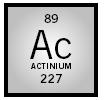Actinium

MELTING POINT:
1,050°C
BOILING POINT
: 3,200°C
DENSITY
: 10.07 g/cm
3
MOST COMMON IONS
: Ac
3+
Actinium has thirty-six isotopes , all of which are radioactive and which range in mass number from 209 to 234. The longest-lived isotope has a mass number of 227 and a half-life of 21.8 years. Actinium was discovered in pitchblende in 1899 by French chemist André-Louis Debierne, a member of the Curie laboratory. He named it actinium , using the Greek word aktis , meaning ray. It was discovered independently by Friedrich Giesel in 1902. Actinium in its ground state has an (outer orbital) electronic configuration of 5 f 0 6 d 7 s 2 . Actinium exists in an oxidation state of 3+ in solution and in its compounds. The isotope 227 Ac is found in uranium ores in concentrations of approximately 0.15 mg per ton of pitchblende, and at lower concentrations, in thorium ores. Pure actinium forms a silvery-white metal that has a face-centered structure near its melting point.
In 1945 Glenn Seaborg proposed that actinium was the first member of a family of fifteen elements (the "actinides"), characterized by the possession of the 5 f orbitals. His proposal was based on the similarity of the chemistry of actinium to that of lanthanum ( atomic number 57), which is the first member of the fifteen elements of the trivalent lanthanide family. Actinium is somewhat more basic than lanthanum but, like lanthanum, forms compounds that have strongly ionic bonds. Many actinium compounds are isostructural with the corresponding compounds of lanthanum, due to the similarities in radii and electronic structures among the two set of compounds. Due to the short half-lives of the isotopes of actinium, no significant uses have been developed for these isotopes.
SEE ALSO Berkelium ; Einsteinium ; Fermium ; Lawrencium ; Mendelevium ; Neptunium ; Nobelium ; Plutonium ; Protactinium ; Rutherfordium ; Seaborg, Glenn Theodore ; Thorium ; Uranium .
Gregory R. Choppin
Bibliography
Choppin, Gregory R.; Liljenzin, Jan-Olov; and Rydberg, Jan (2001). Radiochemistry and Nuclear Chemistry , 3rd edition. Woburn, MA: Butterworth-Heinemann.
Comment about this article, ask questions, or add new information about this topic: